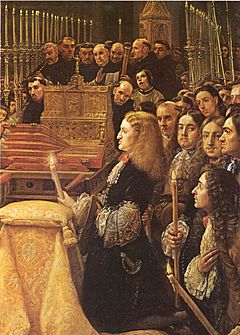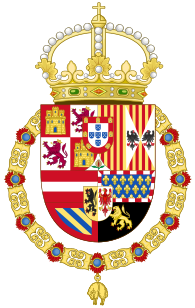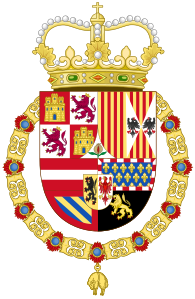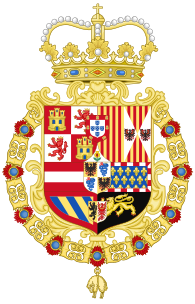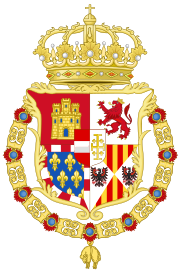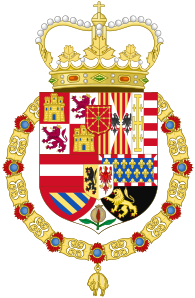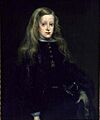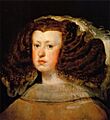Charles II of Spain facts for kids
Quick facts for kids Charles II |
|
|---|---|
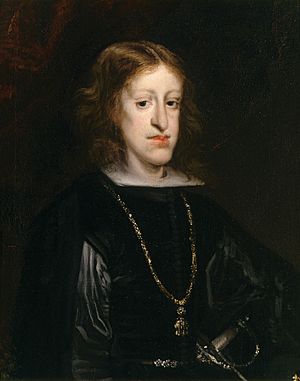
Portrait of Charles II by Juan Carreño de Miranda, c. 1680, Prado
|
|
| King of Spain (more...) | |
| Reign | 17 September 1665 – 1 November 1700 |
| Predecessor | Philip IV |
| Successor | Philip V |
| Regent | Mariana of Austria (1665–1675) |
| Born | 6 November 1661 Royal Alcazar of Madrid, Spain |
| Died | 1 November 1700 (aged 38) Royal Alcazar of Madrid, Spain |
| Burial | Monasterio del Escorial |
| Spouse | |
| House | Habsburg |
| Father | Philip IV of Spain |
| Mother | Mariana of Austria |
| Religion | Roman Catholicism |
| Signature |  |
Charles II (Spanish: Carlos II, born 6 November 1661 – died 1 November 1700) was the last king from the Habsburg family to rule the Spanish Empire. He was sometimes called "the Bewitched" (Spanish: El Hechizado) because people thought his health problems were due to magic.
Charles became king in 1665 when he was only three years old. His reign is often remembered for his health issues and the big war that happened after he died, called the War of the Spanish Succession. However, many of the problems Spain faced were already there before he became king. Some historians now think his time as king was more successful than people used to believe.
Even though Charles had many health challenges, his empire stayed mostly together. Spain also played an important role in stopping the powerful King Louis XIV of France from expanding his lands. Charles married twice, but he didn't have any children. When he died in 1700, his nephew Philip of Anjou became the new king. But this led to a major war across Europe.
Contents
About Charles II
His Family and Early Life
Charles II was born on 6 November 1661. He was the only son of Philip IV of Spain and Mariana of Austria. His parents were actually uncle and niece. In royal families back then, it was common for relatives to marry to keep power and wealth within the family. The Habsburg family, both in Spain and Austria, did this a lot.
This practice of marrying within the family might have caused some of Charles's health problems. For example, many Habsburgs had a distinct jaw shape, sometimes called the 'Habsburg jaw'. Charles's jaw was so pronounced that it made it hard for him to chew his food properly, leading to stomach issues.
Health Challenges
Charles faced many illnesses from a young age. He survived childhood diseases like measles, chickenpox, rubella, and smallpox, which were very dangerous at the time. He also had rickets, a bone disease, which meant he couldn't walk by himself until he was four years old. He even had to wear leg braces until he was five.
Some people thought Charles wasn't very smart because of his health. But this isn't true. He had tutors from a young age, including a professor from the University of Salamanca. He also learned music and mathematics. Reports from people who met him, like diplomats from other countries, said he was friendly and generous, even if he was a bit shy. He was also very active and enjoyed hunting.
Charles's Time as King
Regency and Early Challenges
When Charles became king in 1665, he was too young to rule. So, his mother, Mariana of Austria, became the Queen Regent. This meant she ruled Spain until Charles was old enough. The Spanish Empire was huge, stretching across the world, but it was facing many challenges. Other countries like the Dutch Republic and England were becoming stronger economically. Also, Louis XIV of France was trying to expand his power in Europe.
Mariana's rule was difficult because she had a power struggle with Charles's older half-brother, Don Juan José de Austria. Spain also had money problems, going bankrupt many times. Mariana tried to end costly wars with France and Portugal, signing peace treaties in 1668.
Taking Control
Don Juan José de Austria kept trying to get more power. In 1675, when Charles was almost 14 (the age he could officially rule), Don Juan pushed Charles to take control. Charles eventually did, and Don Juan became a powerful figure in the government.
Don Juan made peace with France in 1678, but Spain had to give up some land. To help improve relations with France, Don Juan arranged for Charles to marry Marie Louise of Orléans in 1679. She was the niece of Louis XIV. Don Juan died shortly after the marriage.
Later Years and Economic Changes
After Don Juan, other powerful nobles helped Charles rule. Spain continued to face economic difficulties, partly due to a period of colder weather across Europe called the "Little Ice Age", which led to bad harvests. The population also decreased. Spain was constantly spending money on wars and defending its large empire.
To fix the money problems, Spanish officials made big changes to the currency in the 1680s. This caused some chaos at first, but it eventually helped stabilize Spain's economy. These changes were important for the future of Spain.
Marie Louise, Charles's first wife, died in 1689. Modern doctors believe she likely died from appendicitis. Charles then married Maria Anna of Neuburg in 1690. She was from a family known for having many children, as everyone hoped Charles would have an heir.
The Succession Question
Who Would Be King Next?
Charles and Marie Louise did not have children. People blamed Marie Louise for this, but it was not her fault. After she died, Charles married Maria Anna, hoping for an heir. However, Charles never had any children with either wife.
This made the question of who would inherit the Spanish throne very important. The Spanish crown could be passed down through female family members. This meant that Charles's sisters, Maria Theresa and Margaret Theresa, could pass their rights to their children.
Maria Theresa had married Louis XIV of France. She had given up her right to the Spanish throne when she married, but Louis XIV was promised a huge payment that was never fully made. Margaret Theresa had married Emperor Leopold. Their daughter, Maria Antonia, had a son named Joseph Ferdinand.
Plans for the Empire
Other European powers, like France, England, and the Dutch Republic, tried to decide who would get parts of the Spanish Empire after Charles died. They made agreements to divide the empire, but Charles and the Spanish people didn't like this. They wanted the empire to stay together and independent.
In 1698, Charles II made Joseph Ferdinand his heir, saying he would inherit an undivided Spanish monarchy. But Joseph Ferdinand died in 1699. This meant Louis XIV's eldest son was next in line, which could have joined Spain and France, making France too powerful.
So, a new plan was made: Emperor Leopold's younger son, Archduke Charles, would become king. But Charles II changed his will again, choosing Louis XIV's grandson, Philip of Anjou, to be his heir. He still insisted that the Spanish monarchy must remain united and independent.
Charles's Death and the War
Most Spanish nobles preferred a French candidate like Philip, as they thought it would better protect Spain's independence. Charles became very ill in September 1700. He died on 1 November 1700, just five days before his 39th birthday.
Philip of Anjou was declared King of Spain on 16 November 1700. However, the other European powers disagreed with this, leading to the start of the War of the Spanish Succession in July 1701.
Charles's Legacy
A Changing Empire
For a long time, Charles II's reign was seen as a time of decline for Spain. But newer studies show that this view might be too simple. Historians now believe that Charles's reign was important for Spain's recovery after many years of problems. It also saw the first major efforts to improve trade and bring new ideas and science into Spain.
Spain's economy relied heavily on silver and gold from the Americas, and these imports actually reached very high levels during Charles's reign. The financial changes made during his rule helped stabilize Spain's money system, which had been very unstable. Many of the economic and political ideas started under Charles were later continued by the kings who followed him.
Arts and New Laws
Charles II wasn't as interested in art as his father, but he still hired famous artists like Luca Giordano and Claudio Coello to decorate royal buildings. Claudio Coello created a very important Spanish painting called Charles II adores the Holy Eucharist in 1690.
In 1693, Charles issued a special law that offered safety in Spanish Florida to enslaved people who escaped from the nearby English colony of South Carolina. This law helped increase the population of Spanish Florida and also created the first legally recognized free Black town in what is now the United States, called Santa Teresa de Mose, founded in 1738.
Namesakes and Universities
Several places were named after Charles II. The Caroline Islands in the Pacific Ocean were named after him in 1666, and the town of Charleroi in modern Belgium was named in 1686.
He also approved the creation of several universities in South America that are still important today. These include San Cristóbal of Huamanga University in Peru (1680), the National University of Saint Anthony the Abbot in Cuzco (Peru), and the Universidad de San Carlos de Guatemala (Guatemala), which is one of the oldest universities on the continent. Other universities approved in his name include Santo Tomas Aquino (now part of the Central University of Ecuador) and the Universidad de San Nicolás de Mira in Bogotá, Colombia.
|
||||||||||||||||||||||||||||||||||||||||||||||||||||||||||||||||||||||||||||||||||||||||||||||||||||||||||||||||||||||||||||||||||||||||||||||||||||||||||||||||||||||||||||||||||||||||||||||||||||||||||||||||||||||||||||||||||||||||||||||||||||||||||||||||||||||||||||||||||||||||||||||||||||||||||||||||||||||||||||||||||||||||||||||||||||||||||||||||||||||||||||||||||||||||||||||||||||||||||||||||||||||||||||||||||||||||||||||||||||||||||||||||||||||||||||||||||||||||||||||||||||||||||||||||||||||||||||||||||||||||||||||||||||||||||||||||||||||||||||||||||||||||||||||||||||||||||||||||||||||||||||||||||||||||||||||||||||||||||||||||||||||||||||||||||||
Heraldry
| Heraldry of Charles II of Spain | ||||||||||||||
|---|---|---|---|---|---|---|---|---|---|---|---|---|---|---|
|
Images for kids
-
Mariana of Austria by Diego Velázquez, around 1656. She was Regent for Charles when he was young.
-
Charles's half-brother, Don Juan José de Austria, who had a power struggle with Mariana.
-
Marie Louise of Orléans, Charles's first wife.
-
Maria Anna of Neuburg, Charles's second wife, who supported Austria.
|
Charles II of Spain
Born: 6 November 1661 Died: 1 November 1700 |
||
| Regnal titles | ||
|---|---|---|
| Preceded by Philip IV |
King of Spain, Sardinia, Naples, and Sicily; Duke of Milan, Lothier, Brabant, Limburg and Luxemburg Count of Flanders, Hainaut and Namur 1665–1700 |
Succeeded by Philip V |
| Count Palatine of Burgundy 1665–1678 |
Annexed by France | |
| Spanish royalty | ||
| Vacant
Title last held by
Philip Prospero |
Prince of Asturias 1661–1665 |
Vacant
Title next held by
Louis Philip |
See also
 In Spanish: Carlos II de España para niños
In Spanish: Carlos II de España para niños


